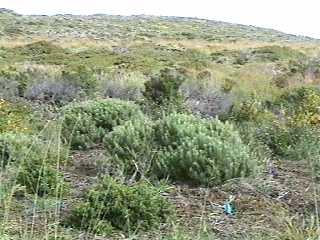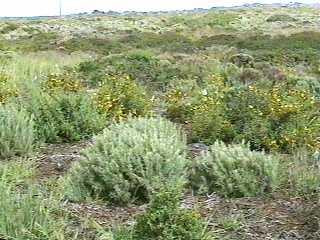A Restoration of a Coastal sage Scrub site.
A Restoration of a Coastal sage Scrub site.
Our most ambitious ecological restoration to date was the 220- acre California Spaceport Systems International Project, Vandenberg Air Force Base, Lompoc, California, U.S.A. Mitigation: Ecological restoration of a coastal sage scrub/coastal chaparral plant community that was being invaded primarily by Carpobrotus edulis, and secondarily by Ehrharta calycina, both plant species indigenous to South Africa. Methodology: Remove the alien species, and reintroduce the indigenous plant community, without utilizing most conventional, horticultural practices, e.g., irrigation, fertilizer, cages, and soil amendments. Plants (Artemisia californica, Baccharis pilularis, Salvia mellifera, Mimulus aurantiacus, etc.) shown are one and a half years old (Click on pictures to observe a larger view).
Biological monitoring revealed a relationship between the distance from mature shrubs of the coastal sage scrub/coastal chaparral plant community, their litter, and populations of alien plant species. The coastal sage scrub/coastal chaparral plant community can effectively inhibit the establishment of populations of Carpobrotus edulis, and Ehrharta calycina, via 60% canopy coverage, and accumulation of their litter. Individually, the presence of the immature, set-out plants, and the indigenous, subshrubs, annuals, and perennials exhibited no measurable effect upon the populations of alien species.
These results, in this particular case, are consistent with our observations that maintenance (suppression of alien, weedy species) until the plant community can mature and achieve 60% canopy coverage, is one major factor vital to the success of an ecological restoration.





